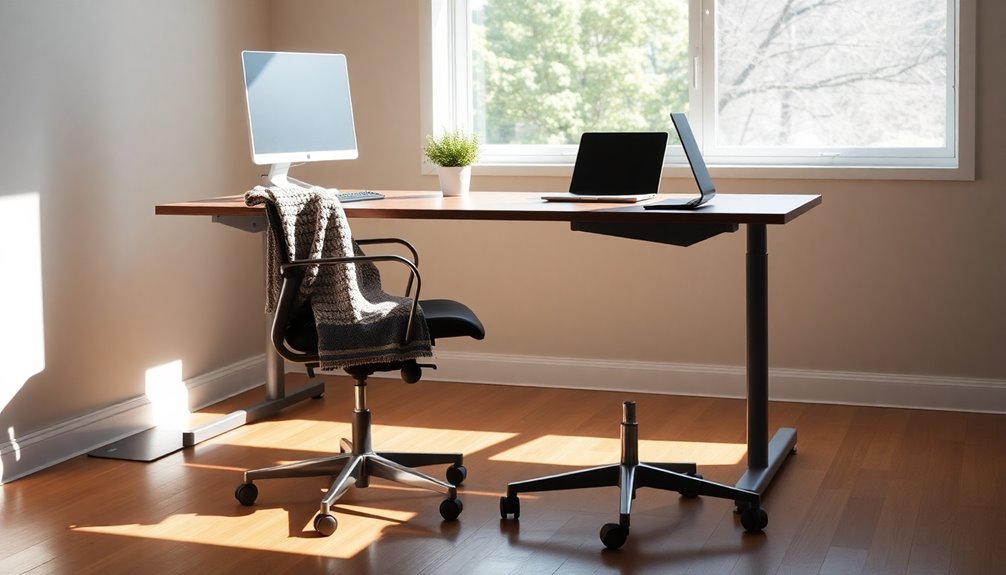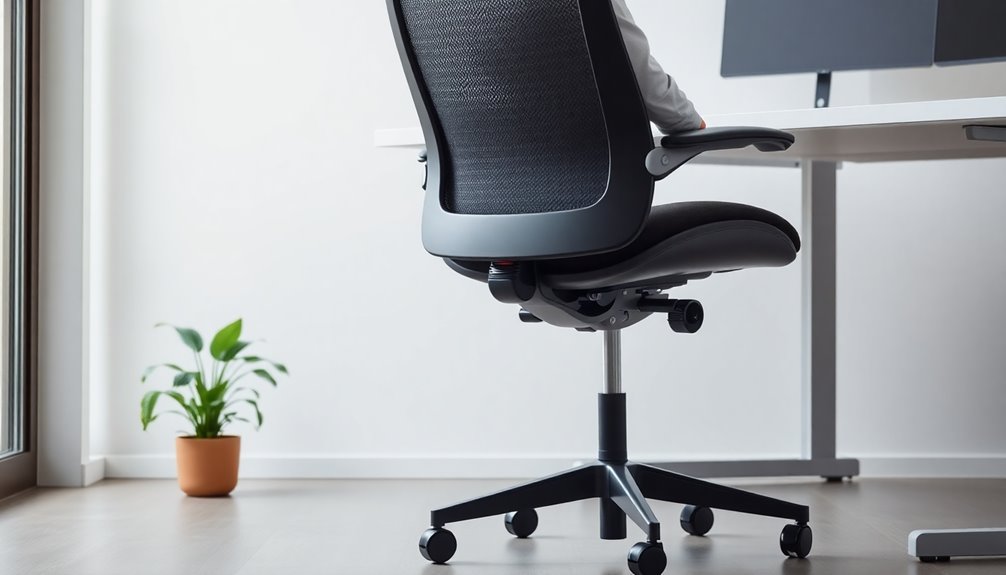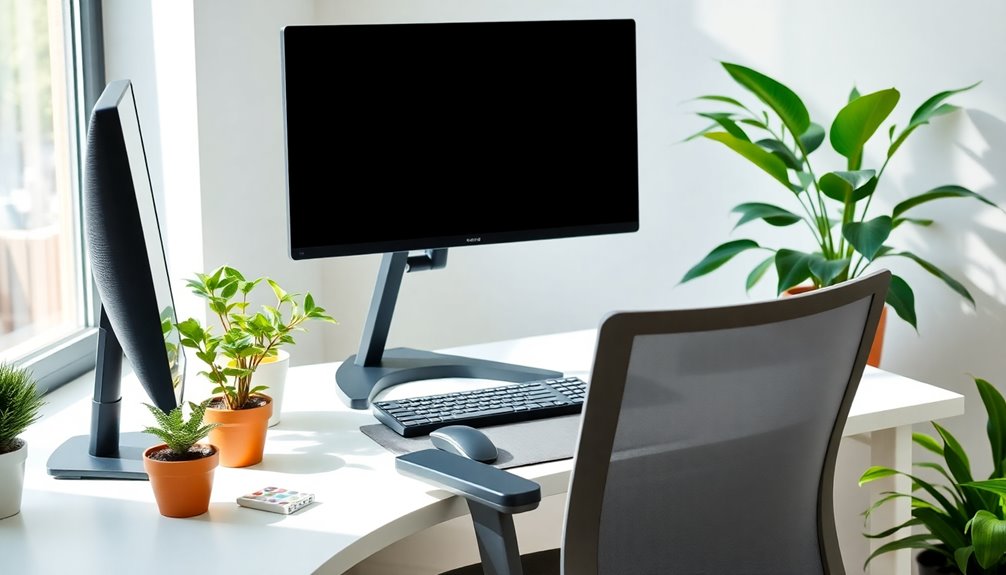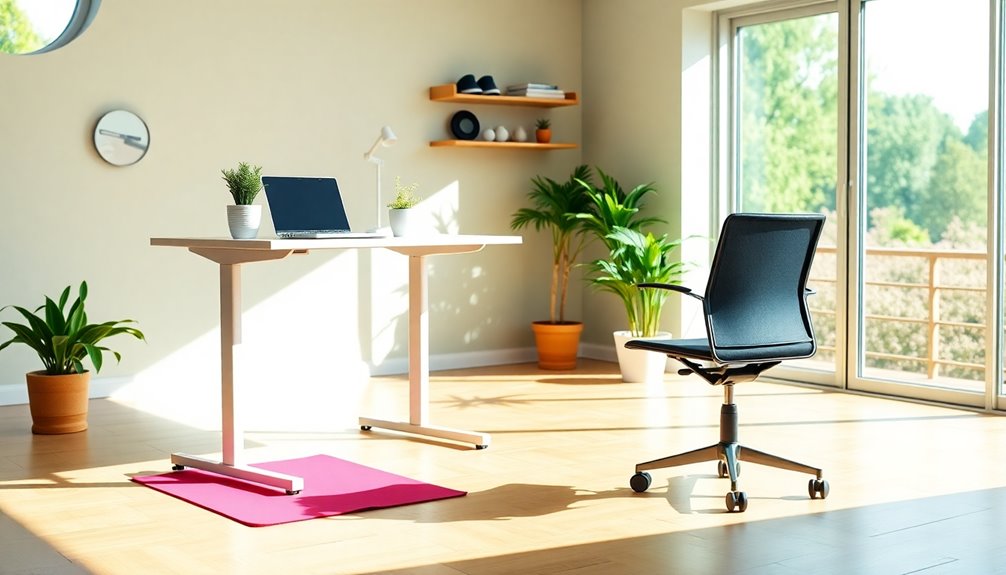To create a comfortable workspace, prioritize ergonomics. Adjust your chair so your feet are flat on the floor and your back has proper support. Position your monitor at eye level, about an arm's length away, and keep your keyboard and mouse on the same surface. Remember to take breaks every hour to stretch and move around. Small adjustments can make a big difference in your comfort and productivity. Explore more ways to enhance your workspace further.
Key Takeaways
- Adjust your chair height so your feet are flat on the floor, ensuring proper support and comfort.
- Position your computer monitor at eye level and an arm's length away to reduce neck strain.
- Keep your keyboard and mouse on the same surface to maintain a relaxed arm position.
- Incorporate adjustable workstations to alternate between sitting and standing throughout the day.
- Encourage regular movement breaks every hour to prevent musculoskeletal disorders and enhance overall well-being.
Importance of Office Ergonomics

When you prioritize office ergonomics, you not only enhance your comfort but also greatly reduce the risk of discomfort and injury associated with long hours of seated work.
A well-thought-out workplace design contributes considerably to employee well-being. By adjusting desk height and ensuring proper posture, you can minimize health problems like back pain and eye strain.
Ergonomically designed workspaces allow for better monitor positioning and keyboard placement, reducing the likelihood of repetitive strain injuries.
Regular movement and posture changes throughout your workday are essential to combat the sedentary behavior that leads to musculoskeletal disorders.
Ultimately, implementing effective office ergonomics enhances not just your comfort but also productivity, making for a healthier, more satisfying work environment. Additionally, creating a workspace that allows for regular inspections can help maintain optimal comfort levels and prevent potential hazards in your work environment.
Chair Setup for Optimal Comfort

To achieve ideal comfort while working, it's crucial to set up your chair correctly. Start by selecting an adjustable chair height so your feet rest flat on the floor and thighs are parallel to the ground. Incorporate lumbar support to maintain your spine's natural curve, preventing discomfort. Verify your arms are length away from the keyboard, with elbows close to your body, forming a 90-degree angle for good posture. Remember to keep the area under your desk clear for ample legroom. Regularly evaluate your chair setup to accommodate any changes in your sitting posture, guaranteeing ongoing support for your health throughout the workday. Notably, ensuring your workspace is free from distractions can further enhance emotional growth and productivity.
| Setup Element | Recommendation |
|---|---|
| Chair Height | Feet flat on the floor |
| Lumbar Support | Maintain spine's natural curve |
| Arm Position | Elbows close, 90-degree angle |
| Desk Area | Keep clear for legroom |
Proper Desk Arrangement and Equipment Positioning

Achieving an organized and efficient workspace hinges on how you arrange your desk and position your equipment.
Position your computer monitor an arm's length away at eye level to maintain proper posture and reduce neck strain. Keep your keyboard and mouse on the same surface, allowing your arms to bend at 90 to 110 degrees while keeping your wrists straight to prevent strain.
Adjust your office chair height so your feet rest flat on the floor, ensuring your thighs are parallel to the ground for proper blood circulation.
Arrange frequently used items within your primary work zone to minimize excessive reaching.
Consider using adjustable desks or monitor stands to customize your workstation height, enhancing ergonomics in the workplace and reducing physical strain.
Additional Tips for Enhancing Ergonomics

How can you further enhance your ergonomic setup? Start by incorporating adjustable workstations to easily switch between sitting and standing, promoting better posture and reducing lower back pain.
Make sure your monitor is positioned at eye level and an arm's length away, which prevents neck strain and maintains a neutral head posture. If you're shorter, use footrests to improve leg positioning, alleviating pressure on your lower back and boosting circulation.
Keep your keyboard and mouse close to reduce stretching, helping maintain a relaxed posture for your upper arms.
Don't forget to take movement breaks every hour; regular stretching can combat the negative effects of static postures and support your overall ergonomics in the work environment.
Encouraging Movement and Activity in the Workplace

Enhancing your ergonomic setup is just the first step; integrating movement and activity into your workplace can further boost your well-being and productivity.
Encourage standing or walking meetings to promote movement, reducing sedentary time and enhancing creativity.
Take short breaks every hour to stretch and walk, as regular movement notably decreases musculoskeletal strain and combats poor posture.
Utilize adjustable desks that let you switch between sitting and standing for improved comfort.
Consider an office layout that encourages walking by placing printers and common areas further from workstations.
Finally, implement wellness programs with challenges for walking more steps daily, fostering a culture of activity.
These strategies align with recommendations from the Health Administration, ensuring comfortable workspaces and healthier employees.
Frequently Asked Questions
How to Design a Workspace Ergonomically?
To design your workspace ergonomically, start by adjusting your chair height so your feet rest flat on the floor, keeping your thighs parallel to the ground.
Position your monitor at eye level to avoid neck strain.
Ascertain your keyboard and mouse are within easy reach to maintain relaxed shoulders.
Consider using adjustable furniture to promote movement throughout the day, and keep frequently used items close to minimize excessive reaching and discomfort.
How Can You Improve Your Workspace to Make It More Ergonomic?
To improve your workspace ergonomically, start by adjusting your chair height so your feet rest flat on the floor.
Position your monitor at eye level, about an arm's length away, to reduce neck strain.
Keep your keyboard and mouse at the same level, maintaining a 90-degree angle with your elbows.
Consider using an adjustable desk to alternate between sitting and standing, and make certain frequently used items are within easy reach to enhance efficiency.
How Ergonomics Can Be Applied to a Workspace?
You can apply ergonomics to your workspace by adjusting your chair so your feet rest flat on the floor, promoting better posture.
Position your monitor at eye level, about an arm's length away, to reduce neck strain.
Consider using an adjustable desk to alternate between sitting and standing.
Keep frequently used items within easy reach to minimize unnecessary movement.
Finally, use ergonomic equipment like split keyboards to enhance comfort and prevent injuries.
What Are the Five Steps for Ergonomic Workstation Design?
To design an ergonomic workstation, start by evaluating your individual needs for chair and desk height.
Position your monitor at arm's length with the top at eye level.
Arrange your keyboard and mouse so your elbows are bent comfortably, keeping your wrists straight.
Consider using adjustable furniture like sit-stand desks to alternate positions.
Finally, make it a habit to take breaks every 30 to 60 minutes to stretch and move around.
Conclusion
By prioritizing ergonomic design in your workspace, you can markedly boost your comfort and productivity. Remember to adjust your chair and desk to suit your needs, and verify your equipment is positioned correctly. Incorporating movement throughout your day can also enhance your overall well-being. With these simple tips, you'll create a workspace that not only feels good but also supports your health. So go ahead, make those changes and enjoy a more comfortable work environment!









